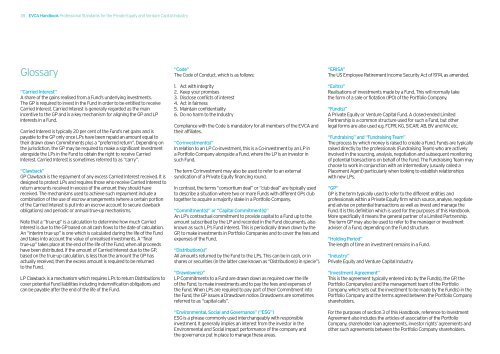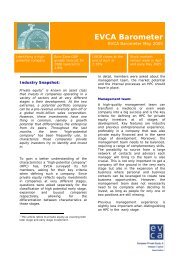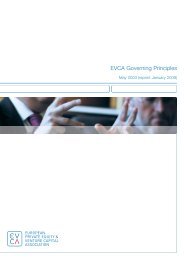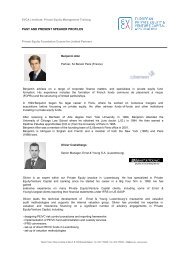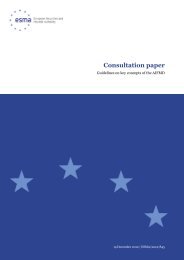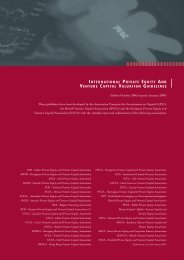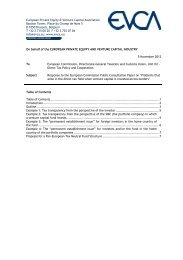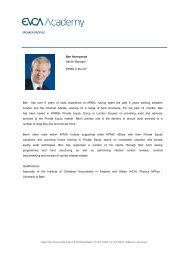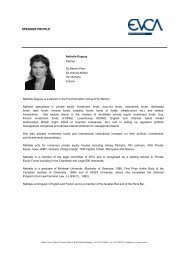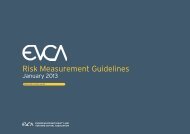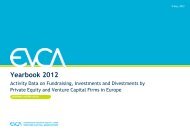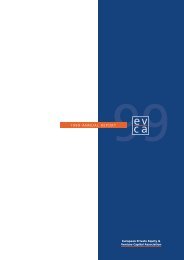EVCA Handbook Professional Standards for the Private Equity and ...
EVCA Handbook Professional Standards for the Private Equity and ...
EVCA Handbook Professional Standards for the Private Equity and ...
- No tags were found...
Create successful ePaper yourself
Turn your PDF publications into a flip-book with our unique Google optimized e-Paper software.
38 <strong>EVCA</strong> <strong>H<strong>and</strong>book</strong> <strong>Professional</strong> <strong>St<strong>and</strong>ards</strong> <strong>for</strong> <strong>the</strong> <strong>Private</strong> <strong>Equity</strong> <strong>and</strong> Venture Capital IndustryGlossary“Carried Interest”A share of <strong>the</strong> gains realised from a Fund’s underlying investments.The GP is required to invest in <strong>the</strong> Fund in order to be entitled to receiveCarried Interest. Carried Interest is generally regarded as <strong>the</strong> mainincentive to <strong>the</strong> GP <strong>and</strong> is a key mechanism <strong>for</strong> aligning <strong>the</strong> GP <strong>and</strong> LPinterests in a Fund.Carried Interest is typically 20 per cent of <strong>the</strong> Fund’s net gains <strong>and</strong> ispayable to <strong>the</strong> GP only once LPs have been repaid an amount equal to<strong>the</strong>ir drawn down Commitments plus a “preferred return”. Depending on<strong>the</strong> jurisdiction, <strong>the</strong> GP may be required to make a significant investmentalongside <strong>the</strong> LPs in <strong>the</strong> Fund to obtain <strong>the</strong> right to receive CarriedInterest. Carried Interest is sometimes referred to as “carry”.“Clawback”GP Clawback is <strong>the</strong> repayment of any excess Carried Interest received. It isdesigned to protect LPs <strong>and</strong> requires those who receive Carried Interest toreturn amounts received in excess of <strong>the</strong> amount <strong>the</strong>y should havereceived. The mechanisms used to achieve such repayment include acombination of <strong>the</strong> use of escrow arrangements (where a certain portionof <strong>the</strong> Carried Interest is put into an escrow account to secure clawbackobligations) <strong>and</strong> periodic or annual true-up mechanisms.Note that a “true-up” is a calculation to determine how much CarriedInterest is due to <strong>the</strong> GP based on all cash flows to <strong>the</strong> date of calculation.An “interim true-up” is one which is calculated during <strong>the</strong> life of <strong>the</strong> Fund<strong>and</strong> takes into account <strong>the</strong> value of unrealised investments. A “finaltrue-up” takes place at <strong>the</strong> end of <strong>the</strong> life of <strong>the</strong> Fund, when all proceedshave been distributed. If <strong>the</strong> amount of Carried Interest due to <strong>the</strong> GP,based on <strong>the</strong> true-up calculation, is less than <strong>the</strong> amount <strong>the</strong> GP hasactually received, <strong>the</strong>n <strong>the</strong> excess amount is required to be returnedto <strong>the</strong> Fund.LP Clawback is a mechanism which requires LPs to return Distributions tocover potential Fund liabilities including indemnification obligations <strong>and</strong>can be payable after <strong>the</strong> end of <strong>the</strong> life of <strong>the</strong> Fund.“Code”The Code of Conduct, which is as follows:1. Act with integrity2. Keep your promises3. Disclose conflicts of interest4. Act in fairness5. Maintain confidentiality6. Do no harm to <strong>the</strong> IndustryCompliance with <strong>the</strong> Code is m<strong>and</strong>atory <strong>for</strong> all members of <strong>the</strong> <strong>EVCA</strong> <strong>and</strong><strong>the</strong>ir affiliates.“Co-investment(s)”In relation to an LP Co-investment, this is a Co-investment by an LP ina Portfolio Company alongside a Fund, where <strong>the</strong> LP is an investor insuch Fund.The term Co-investment may also be used to refer to an externalsyndication of a <strong>Private</strong> <strong>Equity</strong> financing round.In contrast, <strong>the</strong> terms “consortium deal” or “club deal” are typically usedto describe a situation where two or more Funds with different GPs clubtoge<strong>the</strong>r to acquire a majority stake in a Portfolio Company.“Commitment(s)” or “Capital Commitment(s)”An LP’s contractual commitment to provide capital to a Fund up to <strong>the</strong>amount subscribed by <strong>the</strong> LP <strong>and</strong> recorded in <strong>the</strong> Fund documents, alsoknown as such LP’s Fund interest. This is periodically drawn down by <strong>the</strong>GP, to make investments in Portfolio Companies <strong>and</strong> to cover <strong>the</strong> fees <strong>and</strong>expenses of <strong>the</strong> Fund.“Distribution(s)”All amounts returned by <strong>the</strong> Fund to <strong>the</strong> LPs. This can be in cash, or inshares or securities (in <strong>the</strong> latter case known as “Distribution(s) in specie”).“Drawdown(s)”LP Commitments to a Fund are drawn down as required over <strong>the</strong> lifeof <strong>the</strong> Fund, to make investments <strong>and</strong> to pay <strong>the</strong> fees <strong>and</strong> expenses of<strong>the</strong> Fund. When LPs are required to pay part of <strong>the</strong>ir Commitment into<strong>the</strong> Fund, <strong>the</strong> GP issues a Drawdown notice. Drawdowns are sometimesreferred to as “capital calls”.“Environmental, Social <strong>and</strong> Governance” (“ESG”)ESG is a phrase commonly used interchangeably with responsibleinvestment. It generally implies an interest from <strong>the</strong> investor in <strong>the</strong>Environmental <strong>and</strong> Social impact per<strong>for</strong>mance of <strong>the</strong> company <strong>and</strong><strong>the</strong> governance put in place to manage <strong>the</strong>se areas.“ERISA”The US Employee Retirement Income Security Act of 1974, as amended.“Exit(s)”Realisations of investments made by a Fund. This will normally take<strong>the</strong> <strong>for</strong>m of a sale or flotation (IPO) of <strong>the</strong> Portfolio Company.“Fund(s)”A <strong>Private</strong> <strong>Equity</strong> or Venture Capital Fund. A closed-ended LimitedPartnership is a common structure used <strong>for</strong> such a Fund, but o<strong>the</strong>rlegal <strong>for</strong>ms are also used e.g. FCPR, KG, SICAR, AB, BV <strong>and</strong> NV, etc.“Fundraising” <strong>and</strong> “Fundraising Team”The process by which money is raised to create a Fund. Funds are typicallyraised directly by <strong>the</strong> professionals (Fundraising Team) who are activelyinvolved in <strong>the</strong> sourcing, analysis, negotiation <strong>and</strong> subsequent monitoringof potential transactions on behalf of <strong>the</strong> Fund. The Fundraising Team maychoose to work in conjunction with an intermediary (usually called aPlacement Agent) particularly when looking to establish relationshipswith new LPs.“GP”GP is <strong>the</strong> term typically used to refer to <strong>the</strong> different entities <strong>and</strong>professionals within a <strong>Private</strong> <strong>Equity</strong> firm which source, analyse, negotiate<strong>and</strong> advise on potential transactions as well as invest <strong>and</strong> manage <strong>the</strong>Fund. It is this definition which is used <strong>for</strong> <strong>the</strong> purposes of this <strong>H<strong>and</strong>book</strong>.More specifically it means <strong>the</strong> general partner of a Limited Partnership.The term GP may also be used to refer to <strong>the</strong> manager or investmentadviser of a Fund, depending on <strong>the</strong> Fund structure.“Holding Period”The length of time an investment remains in a Fund.“Industry”<strong>Private</strong> <strong>Equity</strong> <strong>and</strong> Venture Capital Industry.“Investment Agreement”This is <strong>the</strong> agreement typically entered into by <strong>the</strong> Fund(s), <strong>the</strong> GP, <strong>the</strong>Portfolio Company(ies) <strong>and</strong> <strong>the</strong> management team of <strong>the</strong> PortfolioCompany, which sets out <strong>the</strong> investment to be made by <strong>the</strong> Fund(s) in <strong>the</strong>Portfolio Company <strong>and</strong> <strong>the</strong> terms agreed between <strong>the</strong> Portfolio Companyshareholders.For <strong>the</strong> purposes of section 3 of this <strong>H<strong>and</strong>book</strong>, reference to InvestmentAgreement also includes <strong>the</strong> articles of association of <strong>the</strong> PortfolioCompany, shareholder loan agreements, investor rights’ agreements <strong>and</strong>o<strong>the</strong>r such agreements between <strong>the</strong> Portfolio Company shareholders.


